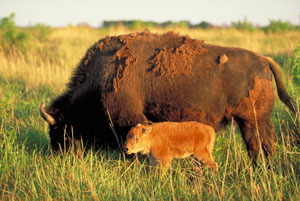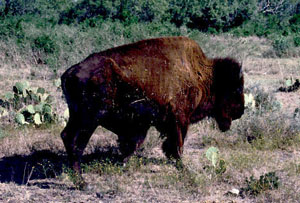Bison
Bison, or buffalo, ranged deeply into south Texas during several periods in the past, apparently as climate fluctuated from drier to more-moist conditions and grasses grew more prolifically. Such climatic intervals may have coincided with periods during which the Central Plains was suffering from drought, thus triggering the movement of bison into regions to the south. The details of bison movements into the region are poorly understood, but there is archeological evidence of their presence and exploitation by native peoples.
During these times, notably in the Late Prehistoric period (roughly A.D. 1300-1600), camps of Late Prehistoric hunters dotted the South Texas Plains. Termed the Toyah horizon, this period saw the rise of specialized "toolkits" for killing and processing large mammals, specifically artiodactyls: deer, antelope, and bison. Among the tools and weapons utilized were the small Perdiz arrowpoint, large chipped-stone knives for cutting meat, and small, “thumbnail”scrapers for processing hides. Evidence from the Hinojosa site (41JW8) in Jim Wells county, 41LK201 in Live Oak County, and Berger Bluff in Goliad County indicates bison were among the hunters’ prey.
The Spanish explorer Cabeza de Vaca journeyed across south Texas during this time and described seeing cows (bison). “Cows come this far and I have seen them three times and have eaten of them…They have small horns, like Moorish cattle, and very long hair, wooly like a rug…. From those that are not large, the Indians make robes to cover themselves and from the larger ones they make shoes and round shields.”
Bison also ranged across the region prior to 9,000 B.C. and during several widely-separated periods thereafter. Bison were not a “normal” part of prehistoric life. We can guess that when herds of the huge creatures entered the region, local peoples must have done everything in their power to take advantage of the reappearing resource. Hunting patterns, hunting methods, group movements, and many other aspects of life would have been altered and it is likely that “foreign” groups from outside the region followed the bison herds. The many resources provided by the animals—meat, hides, sinews, bones, hooves, horns, and even dung —used for food, covering, clothing, cording, tools, glue, containers, and fuel, made them a "walking grocery store," to be utilized to the fullest when available.

